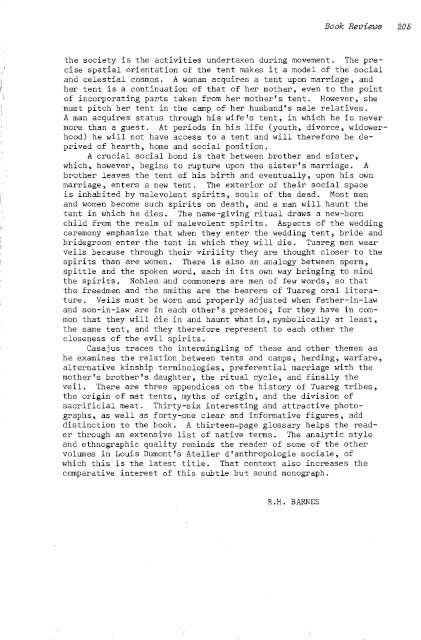CONTENTS NO.I - Institute of Social and Cultural Anthropology ...
CONTENTS NO.I - Institute of Social and Cultural Anthropology ...
CONTENTS NO.I - Institute of Social and Cultural Anthropology ...
Create successful ePaper yourself
Turn your PDF publications into a flip-book with our unique Google optimized e-Paper software.
Book Reviews 205<br />
the society is the activities undertaken during movement. The precise<br />
spatial orientation <strong>of</strong> the tent makes it a model <strong>of</strong> the social<br />
<strong>and</strong> celestial cosmos. A woman acquires a tent upon marriage, <strong>and</strong><br />
her tent is a continuation <strong>of</strong> that <strong>of</strong> her mother, even to the point<br />
<strong>of</strong> incorporating parts taken from her mother's tent. However, she<br />
must pitch her tent in the camp <strong>of</strong> her husb<strong>and</strong>'s male relatives.<br />
A man acquires status through his wife's tent, in which he is never<br />
more than a guest. At periods in his life (youth, divorce, widowerhood)<br />
he will not have access to a tent <strong>and</strong> will therefore be deprived<br />
<strong>of</strong> hearth, home <strong>and</strong> social position.<br />
A crucial social bond is that between brother <strong>and</strong> sister,<br />
which, however, begins to rupture upon the sister's marriage. A<br />
brother leaves the tent <strong>of</strong> his birth <strong>and</strong> eventually, upon his own<br />
marriage, enters a new tent. The exterior <strong>of</strong> their social space<br />
is inhabited by malevolent , souls <strong>of</strong> the dead. Most men<br />
<strong>and</strong> women become such $pirits on death, <strong>and</strong> a man will haunt the<br />
tent in which he dies. The name-giving ritual draws a new-born<br />
child from the realm <strong>of</strong> malevolent spirits. Aspects <strong>of</strong> the wedding<br />
ceremony emphasize that when they enter the wedding tent, bride <strong>and</strong><br />
bridegroom enter the tent in which they will die. Tuareg men wear<br />
veils because through their virility they are thought closer to the<br />
spirits than are women. There is also an analogy between sperm,<br />
spittle <strong>and</strong> the spoken word, each in its own way bringing to mind<br />
the spirits. Nobles <strong>and</strong> commoners are men <strong>of</strong> few words, so that<br />
the freedmen <strong>and</strong> the smiths are the bearers <strong>of</strong> Tuareg oral literature.<br />
Veils must be worn <strong>and</strong> properly adjusted when father-in-law<br />
<strong>and</strong> son-in-law are in each other's presence; for they have in common<br />
that they will die in <strong>and</strong> haunt what is, symbolically at least,<br />
the same tent, <strong>and</strong> they therefore represent to each other the<br />
closeness <strong>of</strong> the evil spirits.<br />
Casajus traces the intermingling <strong>of</strong> these <strong>and</strong> other themes as<br />
he examines the relation between tents <strong>and</strong> camps, herding, warfare,<br />
alternative kinship terminologies, preferential marriage with the<br />
mother's brother's daughter, the ritual cycle, <strong>and</strong> finally the<br />
veil. There are three appendices on the history <strong>of</strong> Tuareg tribes,<br />
the origin <strong>of</strong> mat tents, myths <strong>of</strong> origin, <strong>and</strong> the division <strong>of</strong><br />
sacrificial meat. Thirty-six interesting <strong>and</strong> attractive photographs,<br />
as well as forty-one clear <strong>and</strong> informative figures, add<br />
distinction to the book. A thirteen-page glossary helps the reader<br />
through an extensive list <strong>of</strong> native terms. The analytic style<br />
<strong>and</strong> ethnographic quality reminds the reader <strong>of</strong> some <strong>of</strong> the other<br />
volumes in Louis Dumont's Atelier d'anthropologie sociale, <strong>of</strong><br />
which this is the latest title. That context also increases the<br />
comparative interest <strong>of</strong> this subtle but sound monograph.<br />
R.H. BARNES

















